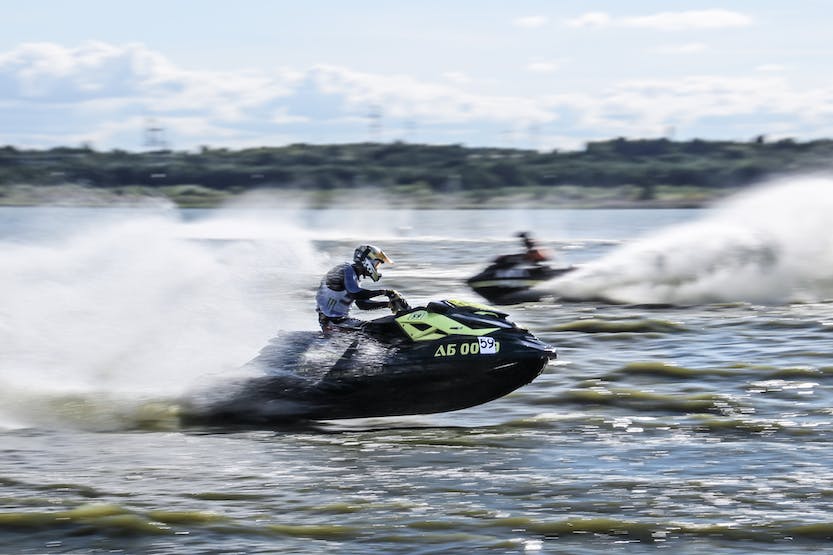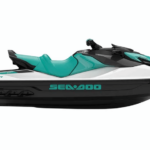Jet skis are a popular watercraft that can provide hours of fun in the sun. One of the most common questions asked by those interested in purchasing or riding a jet ski is, “How fast do jet skis go?”
The answer to this question depends on various factors, such as the make and model of the jet ski, the engine power, and the weight of the rider.
Generally, jet skis can reach speeds between 42-67 mph, with the slowest models being the Rec-Lite models with a top speed of 42-50 mph, and the fastest models reaching up to 67 mph.
However, it is important to note that these are the top speeds of stock jet skis with no modifications.
Some jet ski enthusiasts may choose to modify their watercraft to increase speed, but it is important to do so safely and legally.
Understanding Jet Ski Performance

Jet skis are an exciting way to enjoy the water, and one of the most important aspects of their performance is speed. Understanding the factors that affect jet ski speed can help you choose the right model and get the most out of your time on the water.
Factors Affecting Speed
Several factors can affect the speed of a jet ski, including the make and model, engine horsepower, hull design, and weight. The most powerful models on the market can reach top speeds of over 60 miles per hour, while entry-level models may be limited to speeds of around 40 miles per hour.
Another important factor to consider is the speed limit in your area. Many waterways have speed limits that vary depending on the location, so it is important to check with your local authorities before hitting the water.
Average Speed Ranges
The average top speed of a stock jet ski is around 57 miles per hour. However, this can vary depending on the make and model. Rec-Lite models are the slowest, with top speeds of around 42-50 miles per hour. Performance models can reach top speeds of up to 67 miles per hour.
Top Speeds of Popular Models
The top speed of a jet ski can vary widely depending on the manufacturer and model. Some of the fastest jet skis on the market include the Sea-Doo RXP-X 300, which can reach speeds of up to 67 miles per hour, and the Kawasaki Ultra 310R, which has a top speed of 67 miles per hour.
It is important to note that these are the top speeds of stock jet skis with no modifications. Modified jet skis can reach even higher speeds, with some of the fastest models reaching over 125 miles per hour.
Overall, understanding the performance specs of a jet ski can help you choose the right model for your needs and get the most out of your time on the water.
Jet Ski Models and Manufacturers

Jet skis are popular watercraft used for recreational purposes. They come in different models and are manufactured by various companies. In this section, we will discuss the different models and manufacturers of jet skis.
Entry-Level to High-End Models
Jet skis are available in different models, ranging from entry-level to high-end. Entry-level models are usually less expensive and have lower horsepower. These models are suitable for beginners and those who are new to jet skiing.
High-end models, on the other hand, are more expensive and have higher horsepower. They are suitable for experienced riders and those who want to do more advanced maneuvers.
Some popular entry-level models include the Sea-Doo Spark and the Yamaha VX Cruiser. These models are designed for beginners and are easy to handle. High-end models include the Sea-Doo RXP-X and the Kawasaki Ultra 310LX. These models are designed for experienced riders and offer more advanced features.
Brand Comparison
There are several companies that manufacture jet skis, including Sea-Doo, Kawasaki, and Yamaha. Each brand has its own unique features and benefits. Sea-Doo is known for its supercharged engines, while Kawasaki is known for its stand-up jet skis. Yamaha is known for its Waverunner models, which are popular among enthusiasts.
Innovation in Jet Ski Production
Research and development in the production of jet skis have led to the creation of more advanced models. For instance, the Sea-Doo RXP-X is one of the world’s fastest production jet skis, with a top speed of over 70 mph. The Sea-Doo Spark, on the other hand, is an example of an innovative entry-level jet ski that is lightweight and easy to handle.
In conclusion, jet skis come in different models and are manufactured by various companies. It is important to choose a model that is suitable for your skill level and experience. Whether you are a beginner or an experienced rider, there is a jet ski that is right for you.
Safety and Regulations
Jet skiing is a thrilling watersport that requires adherence to safety and regulations to ensure the safety of the rider and other watercraft users. This section outlines some of the safe riding practices, speed limits, and coast guard guidelines that jet ski riders should follow.
Safe Riding Practices
Before embarking on a jet ski ride, it is essential to wear a properly fitting life jacket. A life jacket is a crucial safety gear that can save a rider’s life in case of an accident. Additionally, riders should ensure that they are familiar with the watercraft’s controls and features before setting out. It is also advisable to ride in pairs or groups, as this increases visibility and enhances safety.
Other safe riding practices include avoiding reckless maneuvers such as sharp turns, jumping wakes, or weaving in and out of other watercraft. Riders should also maintain a safe distance from other boats, swimmers, and other watercraft to avoid accidents.
Speed Limits and Coast Guard Guidelines
The U.S. Coast Guard sets speed limits and guidelines for jet ski riders. The guidelines require riders to maintain a safe speed and distance from other watercraft, swimmers, and other boats.
The speed limit in most areas is 5-10 mph within 100 feet of a shore, dock, or any other structure. In areas where there are no speed limits, jet ski riders should maintain a safe speed that does not endanger other watercraft users.
Additionally, the Coast Guard requires all jet ski riders to have a valid boating license and to follow all watercraft regulations. These regulations include carrying proper safety equipment, such as a life jacket, whistle, and fire extinguisher. Riders should also avoid riding under the influence of alcohol or drugs, as this impairs judgment and increases the risk of accidents.
In conclusion, jet skiing is a fun and exciting watersport that requires adherence to safety and regulations to ensure the safety of the rider and other watercraft users. By following safe riding practices, speed limits, and coast guard guidelines, jet ski riders can enjoy the sport while minimizing the risk of accidents.
Enhancing Jet Ski Experience

Jet skiing is a fun and thrilling water sport that can be enjoyed by people of all ages. To make the most of your jet ski experience, it is important to consider some factors that can enhance your ride. Here are some tips to help you enhance your jet ski experience.
Accessories and Modifications
Accessories and modifications can help improve the performance of your jet ski. For instance, adding a chine to the hull can improve the handling and maneuverability of the jet ski.
Upgrading the impeller can also increase thrust and acceleration, allowing you to reach higher speeds. You can also add storage solutions such as a storage compartment or gear bag to keep your belongings safe and secure while you ride.
Maintenance and Care
Proper maintenance and care can help prolong the life of your jet ski and keep it running smoothly. It is important to follow the manufacturer’s recommended maintenance schedule and perform regular inspections to ensure that all components are in good working condition.
You should also store your jet ski in a dry and secure location to protect it from the elements, especially if you live in an area with high humidity.
Storage Solutions
Having the right storage solutions can make a big difference in your jet ski experience. If you rent a jet ski, make sure that the rental company provides a secure and safe storage location. If you own a jet ski, consider investing in a storage cover to protect it from the elements. Additionally, you can install a fuel stabilizer to prevent fuel from degrading over time and causing damage to your jet ski’s engine.
In conclusion, enhancing your jet ski experience involves considering factors such as accessories and modifications, maintenance and care, and storage solutions. By following these tips, you can ensure that your jet ski runs smoothly and lasts for years to come.
Final Thoughts
Jet skis are a thrilling way to enjoy the water and experience the rush of speed. Whether you are a beginner or an experienced rider, it is important to understand how fast these machines can go and the factors that affect their speed.
As discussed earlier, the top speed of a jet ski can vary depending on the make and model. The slowest jet skis can reach speeds of around 42-50 mph, while the fastest can reach an impressive 67 mph or more. It is important to note that these speeds are for stock jet skis with no modifications.
Factors such as engine power, weight, and water conditions can all affect the speed of a jet ski. Riders should always be aware of their surroundings and take proper safety precautions to ensure a safe and enjoyable ride.
In conclusion, jet skis are capable of reaching high speeds and providing an exhilarating experience on the water. However, it is important to always ride responsibly and within your skill level. With proper knowledge and precautions, jet skiing can be a fun and safe activity for all to enjoy.









![Read more about the article How to Make a Fiberglass Mold from an Existing Part [9 Steps]](https://boatinggeeks.com/wp-content/uploads/2021/03/how-to-make-a-fiberglass-mold-from-an-existing-part-300x200.jpg)